HI5019 Flight Centre Case Study: Tech Implementation & Security
VerifiedAdded on 2024/06/03
|18
|4446
|177
Case Study
AI Summary
This case study provides a comprehensive analysis of Flight Centre, a prominent travel agency, focusing on its business processes, system requirements, and technology implementation. It begins by defining Flight Centre's front and back-office operations, including booking, customer administration, supplier management, and financial oversight. The study then outlines the business requirements for travel agents, emphasizing daily tasks, educational qualifications, and essential skills. It identifies system requirements related to risk and compliance management, highlighting the need for a centralized data collection and monitoring system. The case study also discusses software and vendor selection, emphasizing the importance of features like reservation management, invoicing, and online booking, with a mention of Flight Centre's use of 'Rezdy' software. Furthermore, it explores how companies can utilize technologies to improve business efficiency through information systems, communication technologies, and automation. The report evaluates the efficiency of technology implementation and examines potential security risks and data breaches, providing guidelines for risk mitigation. The study concludes by summarizing key findings and offering recommendations for Flight Centre.
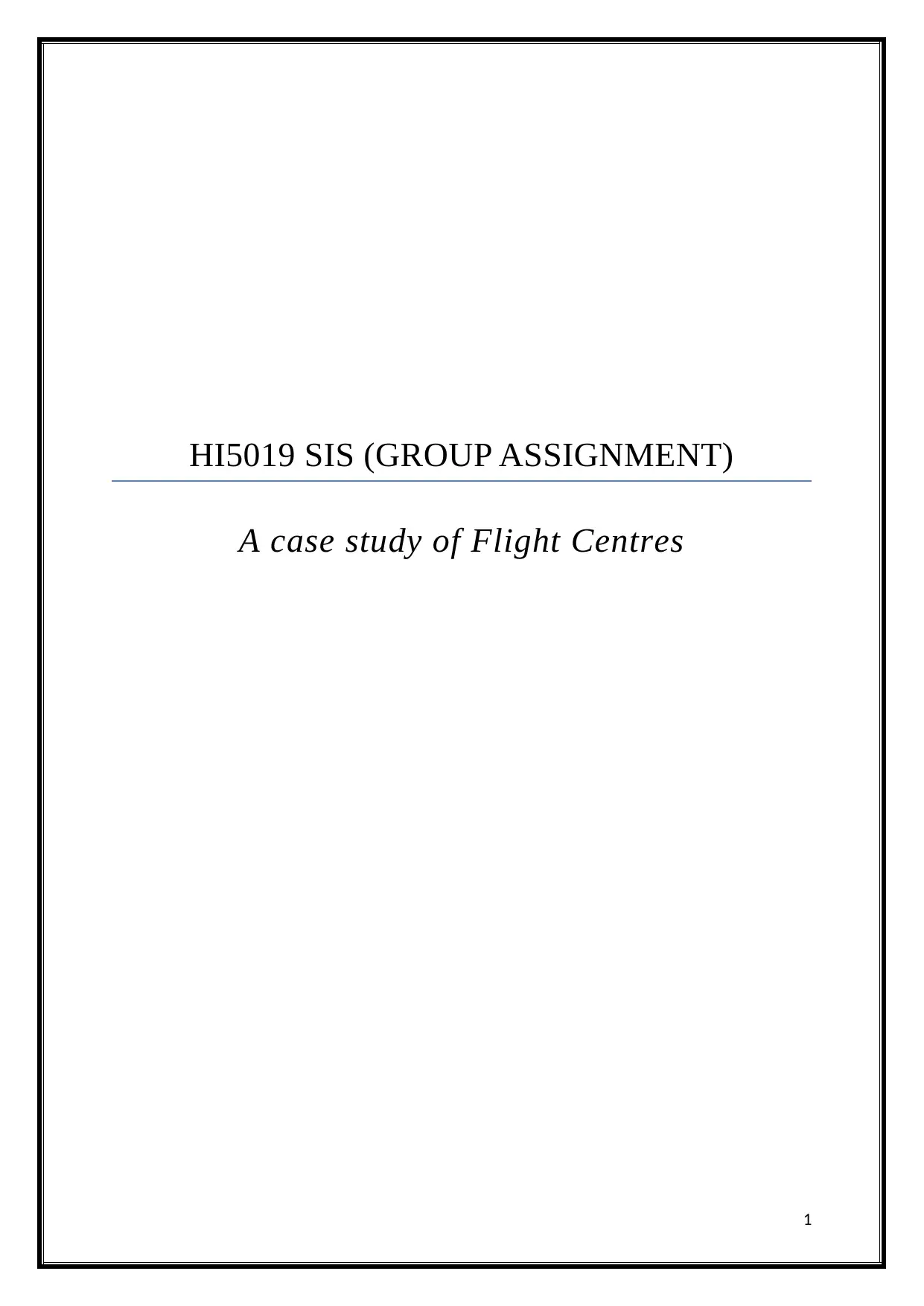
HI5019 SIS (GROUP ASSIGNMENT)
A case study of Flight Centres
1
A case study of Flight Centres
1
Paraphrase This Document
Need a fresh take? Get an instant paraphrase of this document with our AI Paraphraser
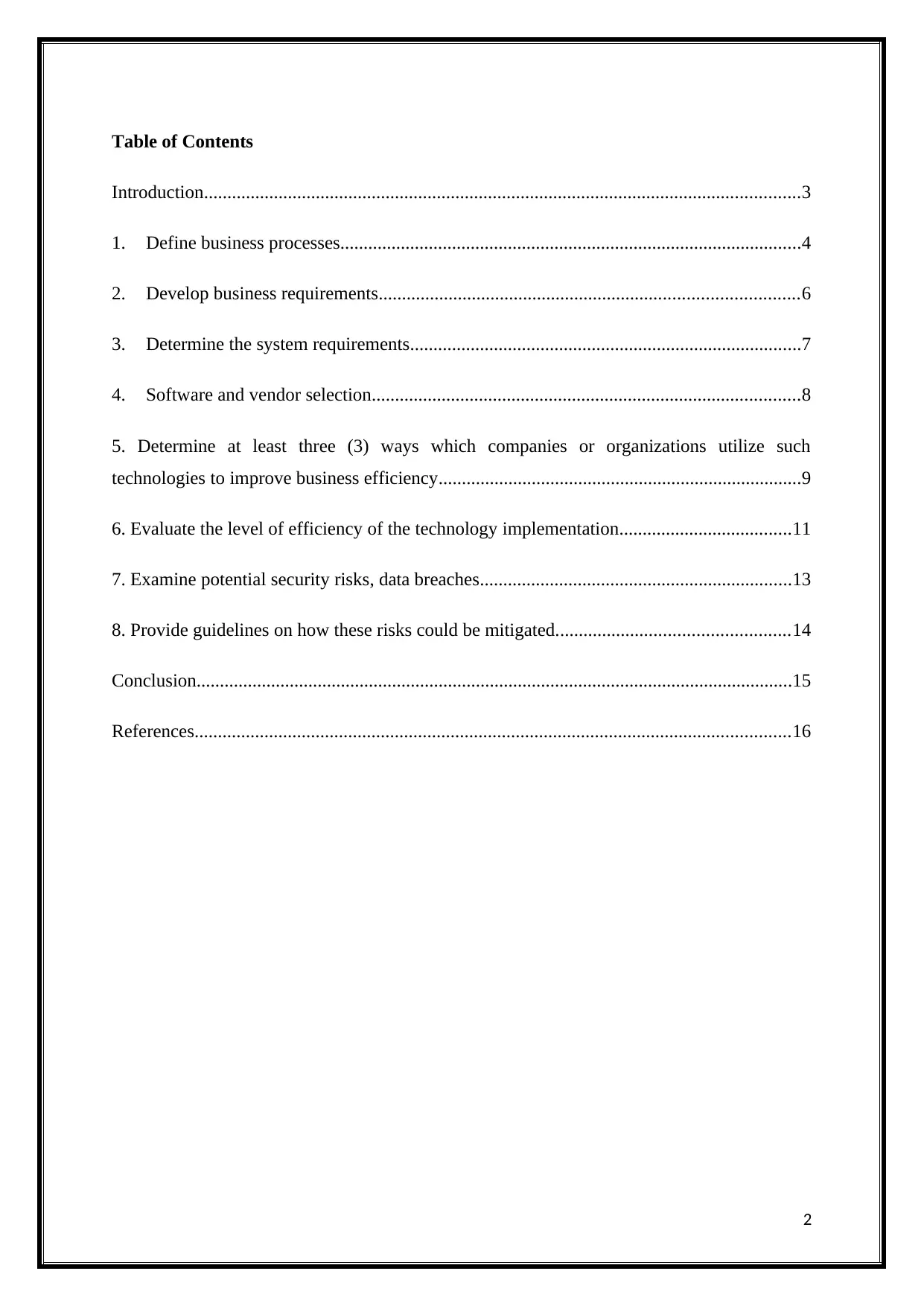
Table of Contents
Introduction................................................................................................................................3
1. Define business processes...................................................................................................4
2. Develop business requirements..........................................................................................6
3. Determine the system requirements....................................................................................7
4. Software and vendor selection............................................................................................8
5. Determine at least three (3) ways which companies or organizations utilize such
technologies to improve business efficiency..............................................................................9
6. Evaluate the level of efficiency of the technology implementation.....................................11
7. Examine potential security risks, data breaches...................................................................13
8. Provide guidelines on how these risks could be mitigated..................................................14
Conclusion................................................................................................................................15
References................................................................................................................................16
2
Introduction................................................................................................................................3
1. Define business processes...................................................................................................4
2. Develop business requirements..........................................................................................6
3. Determine the system requirements....................................................................................7
4. Software and vendor selection............................................................................................8
5. Determine at least three (3) ways which companies or organizations utilize such
technologies to improve business efficiency..............................................................................9
6. Evaluate the level of efficiency of the technology implementation.....................................11
7. Examine potential security risks, data breaches...................................................................13
8. Provide guidelines on how these risks could be mitigated..................................................14
Conclusion................................................................................................................................15
References................................................................................................................................16
2
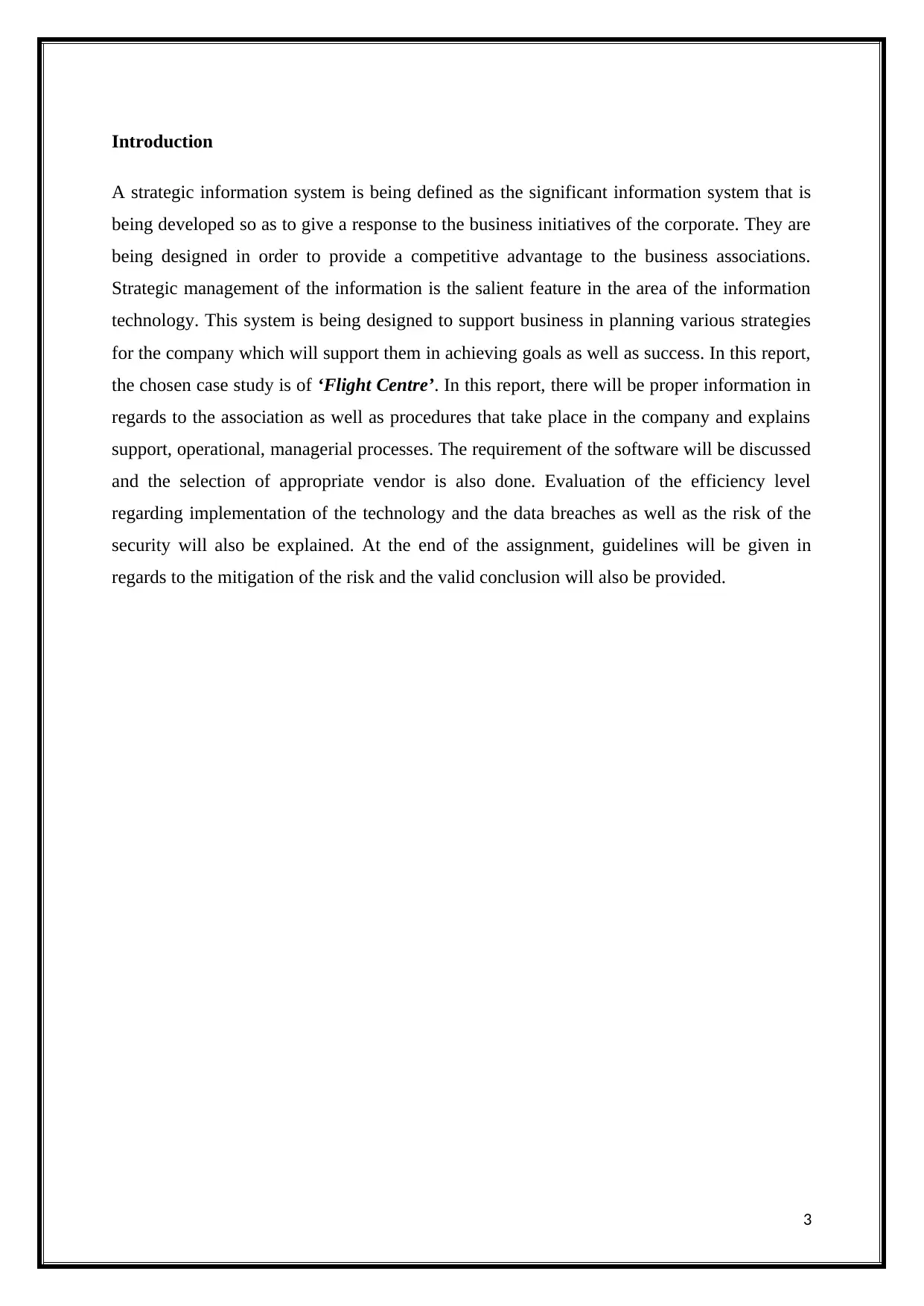
Introduction
A strategic information system is being defined as the significant information system that is
being developed so as to give a response to the business initiatives of the corporate. They are
being designed in order to provide a competitive advantage to the business associations.
Strategic management of the information is the salient feature in the area of the information
technology. This system is being designed to support business in planning various strategies
for the company which will support them in achieving goals as well as success. In this report,
the chosen case study is of ‘Flight Centre’. In this report, there will be proper information in
regards to the association as well as procedures that take place in the company and explains
support, operational, managerial processes. The requirement of the software will be discussed
and the selection of appropriate vendor is also done. Evaluation of the efficiency level
regarding implementation of the technology and the data breaches as well as the risk of the
security will also be explained. At the end of the assignment, guidelines will be given in
regards to the mitigation of the risk and the valid conclusion will also be provided.
3
A strategic information system is being defined as the significant information system that is
being developed so as to give a response to the business initiatives of the corporate. They are
being designed in order to provide a competitive advantage to the business associations.
Strategic management of the information is the salient feature in the area of the information
technology. This system is being designed to support business in planning various strategies
for the company which will support them in achieving goals as well as success. In this report,
the chosen case study is of ‘Flight Centre’. In this report, there will be proper information in
regards to the association as well as procedures that take place in the company and explains
support, operational, managerial processes. The requirement of the software will be discussed
and the selection of appropriate vendor is also done. Evaluation of the efficiency level
regarding implementation of the technology and the data breaches as well as the risk of the
security will also be explained. At the end of the assignment, guidelines will be given in
regards to the mitigation of the risk and the valid conclusion will also be provided.
3
⊘ This is a preview!⊘
Do you want full access?
Subscribe today to unlock all pages.

Trusted by 1+ million students worldwide
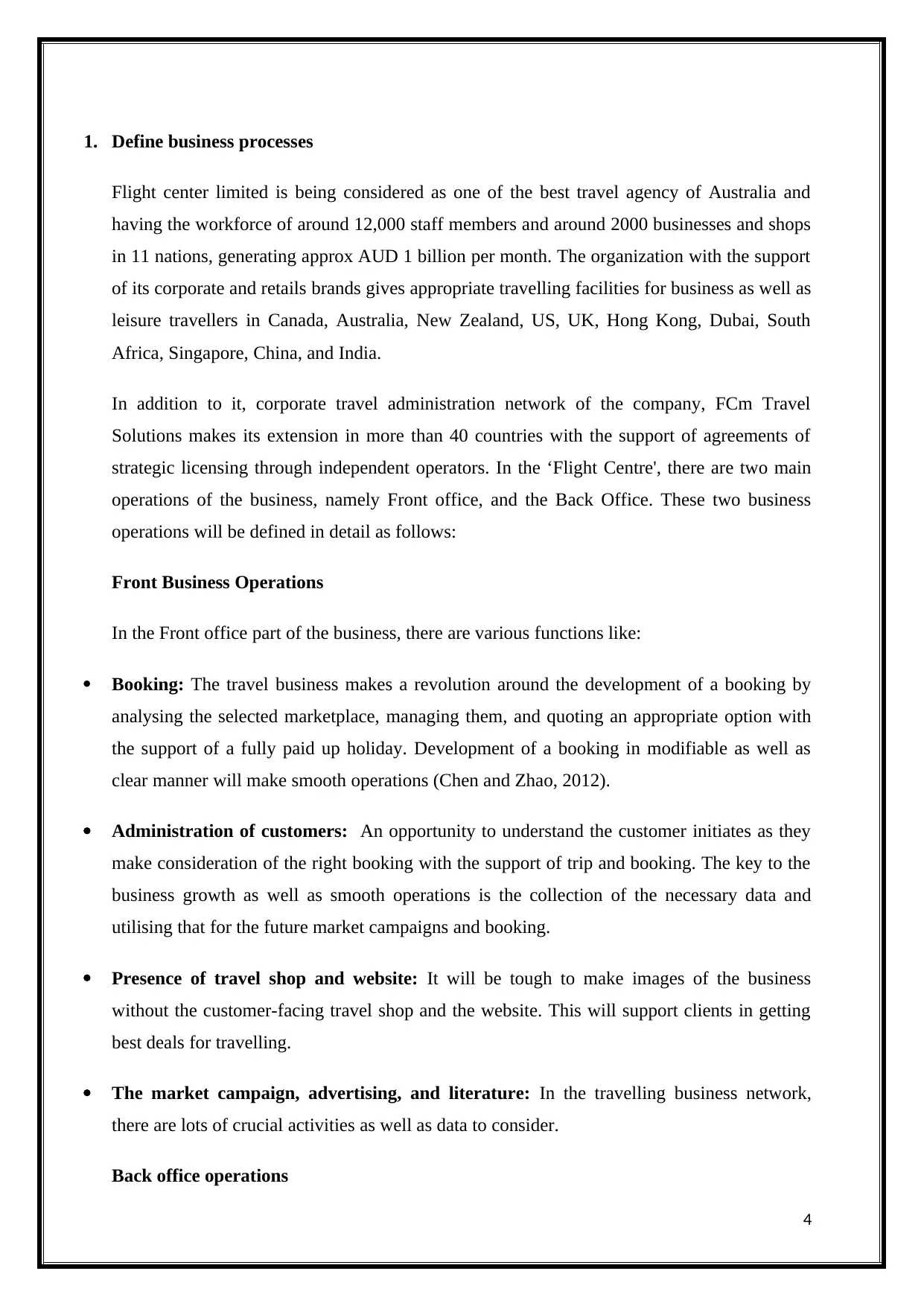
1. Define business processes
Flight center limited is being considered as one of the best travel agency of Australia and
having the workforce of around 12,000 staff members and around 2000 businesses and shops
in 11 nations, generating approx AUD 1 billion per month. The organization with the support
of its corporate and retails brands gives appropriate travelling facilities for business as well as
leisure travellers in Canada, Australia, New Zealand, US, UK, Hong Kong, Dubai, South
Africa, Singapore, China, and India.
In addition to it, corporate travel administration network of the company, FCm Travel
Solutions makes its extension in more than 40 countries with the support of agreements of
strategic licensing through independent operators. In the ‘Flight Centre', there are two main
operations of the business, namely Front office, and the Back Office. These two business
operations will be defined in detail as follows:
Front Business Operations
In the Front office part of the business, there are various functions like:
Booking: The travel business makes a revolution around the development of a booking by
analysing the selected marketplace, managing them, and quoting an appropriate option with
the support of a fully paid up holiday. Development of a booking in modifiable as well as
clear manner will make smooth operations (Chen and Zhao, 2012).
Administration of customers: An opportunity to understand the customer initiates as they
make consideration of the right booking with the support of trip and booking. The key to the
business growth as well as smooth operations is the collection of the necessary data and
utilising that for the future market campaigns and booking.
Presence of travel shop and website: It will be tough to make images of the business
without the customer-facing travel shop and the website. This will support clients in getting
best deals for travelling.
The market campaign, advertising, and literature: In the travelling business network,
there are lots of crucial activities as well as data to consider.
Back office operations
4
Flight center limited is being considered as one of the best travel agency of Australia and
having the workforce of around 12,000 staff members and around 2000 businesses and shops
in 11 nations, generating approx AUD 1 billion per month. The organization with the support
of its corporate and retails brands gives appropriate travelling facilities for business as well as
leisure travellers in Canada, Australia, New Zealand, US, UK, Hong Kong, Dubai, South
Africa, Singapore, China, and India.
In addition to it, corporate travel administration network of the company, FCm Travel
Solutions makes its extension in more than 40 countries with the support of agreements of
strategic licensing through independent operators. In the ‘Flight Centre', there are two main
operations of the business, namely Front office, and the Back Office. These two business
operations will be defined in detail as follows:
Front Business Operations
In the Front office part of the business, there are various functions like:
Booking: The travel business makes a revolution around the development of a booking by
analysing the selected marketplace, managing them, and quoting an appropriate option with
the support of a fully paid up holiday. Development of a booking in modifiable as well as
clear manner will make smooth operations (Chen and Zhao, 2012).
Administration of customers: An opportunity to understand the customer initiates as they
make consideration of the right booking with the support of trip and booking. The key to the
business growth as well as smooth operations is the collection of the necessary data and
utilising that for the future market campaigns and booking.
Presence of travel shop and website: It will be tough to make images of the business
without the customer-facing travel shop and the website. This will support clients in getting
best deals for travelling.
The market campaign, advertising, and literature: In the travelling business network,
there are lots of crucial activities as well as data to consider.
Back office operations
4
Paraphrase This Document
Need a fresh take? Get an instant paraphrase of this document with our AI Paraphraser
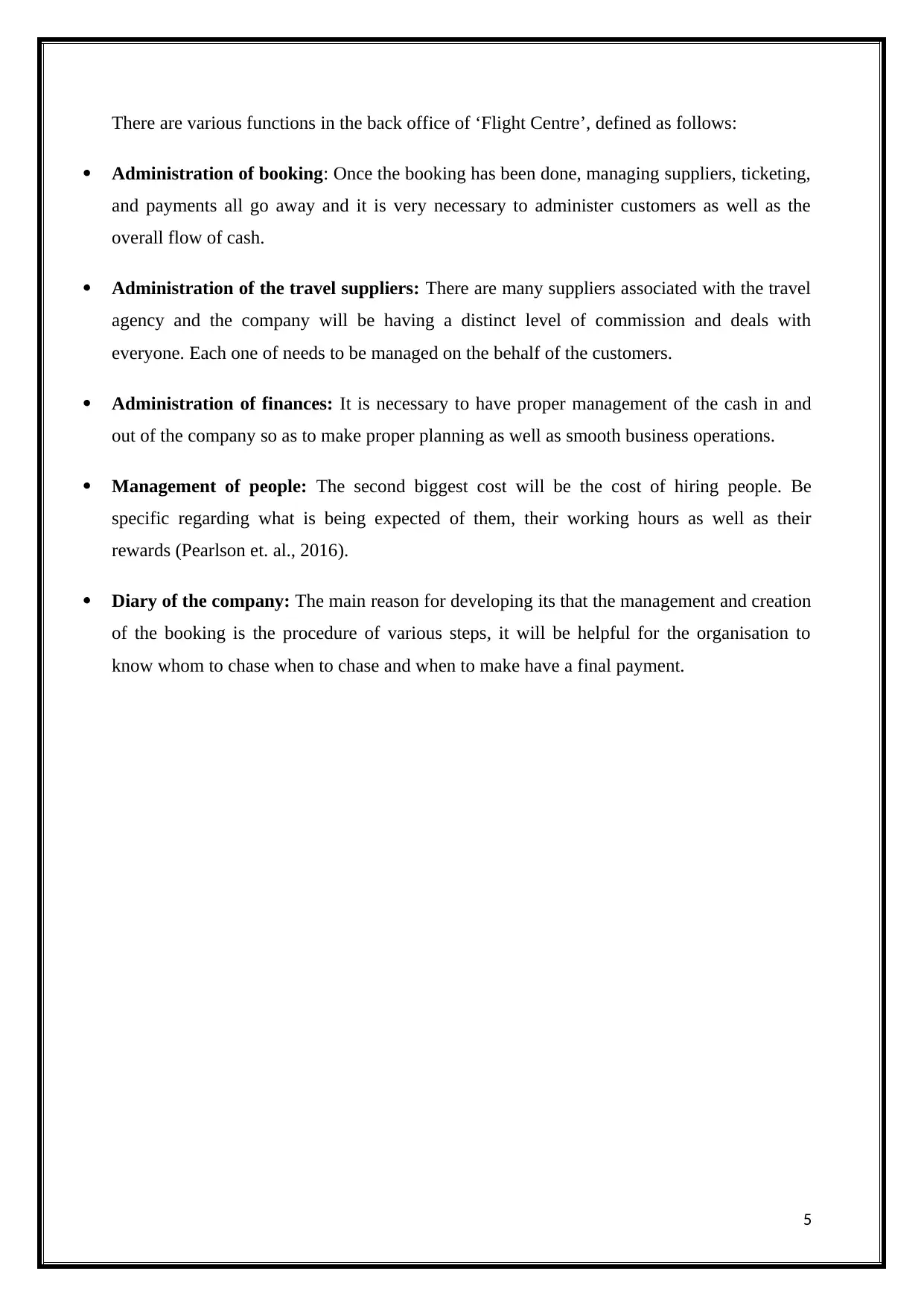
There are various functions in the back office of ‘Flight Centre’, defined as follows:
Administration of booking: Once the booking has been done, managing suppliers, ticketing,
and payments all go away and it is very necessary to administer customers as well as the
overall flow of cash.
Administration of the travel suppliers: There are many suppliers associated with the travel
agency and the company will be having a distinct level of commission and deals with
everyone. Each one of needs to be managed on the behalf of the customers.
Administration of finances: It is necessary to have proper management of the cash in and
out of the company so as to make proper planning as well as smooth business operations.
Management of people: The second biggest cost will be the cost of hiring people. Be
specific regarding what is being expected of them, their working hours as well as their
rewards (Pearlson et. al., 2016).
Diary of the company: The main reason for developing its that the management and creation
of the booking is the procedure of various steps, it will be helpful for the organisation to
know whom to chase when to chase and when to make have a final payment.
5
Administration of booking: Once the booking has been done, managing suppliers, ticketing,
and payments all go away and it is very necessary to administer customers as well as the
overall flow of cash.
Administration of the travel suppliers: There are many suppliers associated with the travel
agency and the company will be having a distinct level of commission and deals with
everyone. Each one of needs to be managed on the behalf of the customers.
Administration of finances: It is necessary to have proper management of the cash in and
out of the company so as to make proper planning as well as smooth business operations.
Management of people: The second biggest cost will be the cost of hiring people. Be
specific regarding what is being expected of them, their working hours as well as their
rewards (Pearlson et. al., 2016).
Diary of the company: The main reason for developing its that the management and creation
of the booking is the procedure of various steps, it will be helpful for the organisation to
know whom to chase when to chase and when to make have a final payment.
5
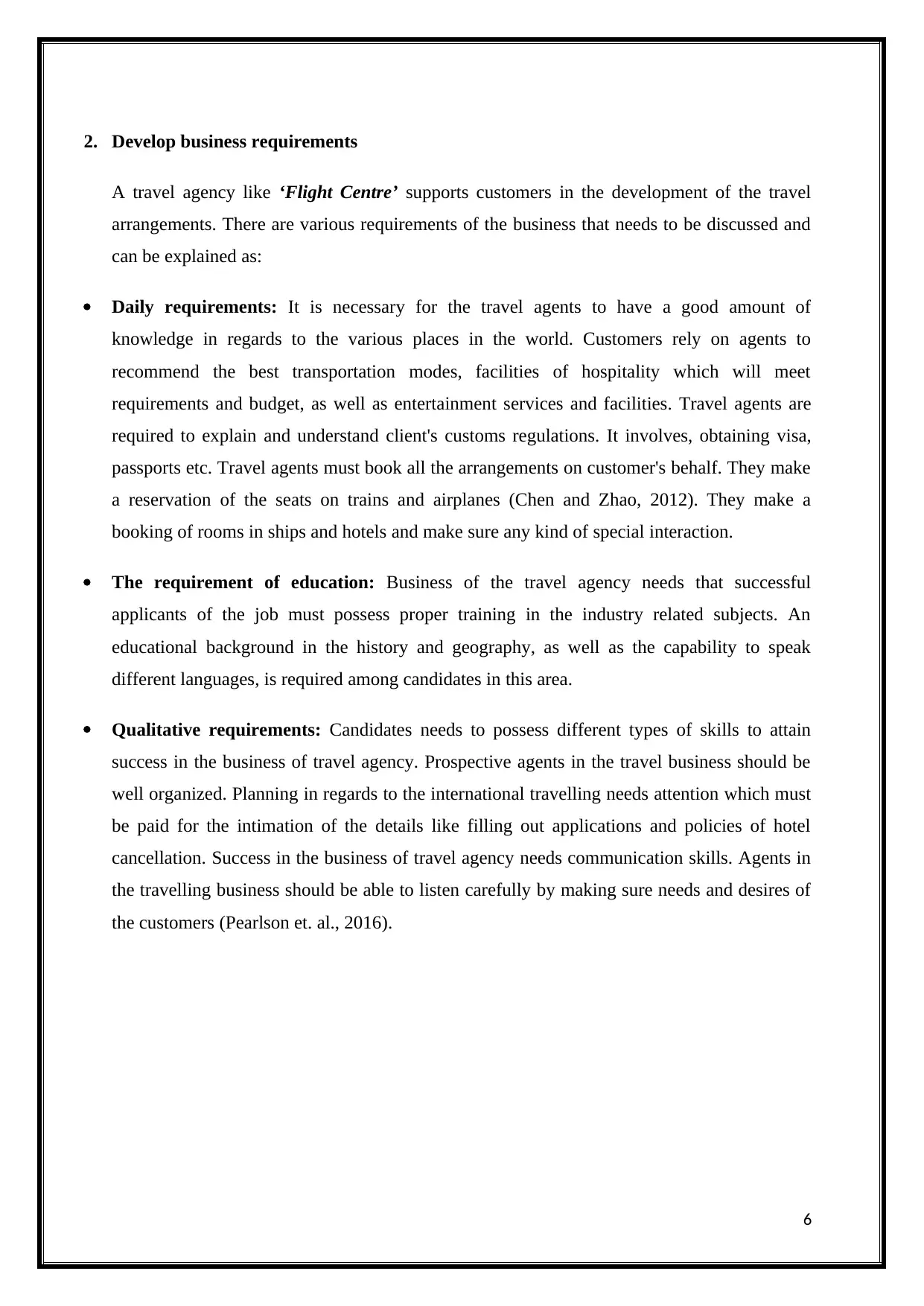
2. Develop business requirements
A travel agency like ‘Flight Centre’ supports customers in the development of the travel
arrangements. There are various requirements of the business that needs to be discussed and
can be explained as:
Daily requirements: It is necessary for the travel agents to have a good amount of
knowledge in regards to the various places in the world. Customers rely on agents to
recommend the best transportation modes, facilities of hospitality which will meet
requirements and budget, as well as entertainment services and facilities. Travel agents are
required to explain and understand client's customs regulations. It involves, obtaining visa,
passports etc. Travel agents must book all the arrangements on customer's behalf. They make
a reservation of the seats on trains and airplanes (Chen and Zhao, 2012). They make a
booking of rooms in ships and hotels and make sure any kind of special interaction.
The requirement of education: Business of the travel agency needs that successful
applicants of the job must possess proper training in the industry related subjects. An
educational background in the history and geography, as well as the capability to speak
different languages, is required among candidates in this area.
Qualitative requirements: Candidates needs to possess different types of skills to attain
success in the business of travel agency. Prospective agents in the travel business should be
well organized. Planning in regards to the international travelling needs attention which must
be paid for the intimation of the details like filling out applications and policies of hotel
cancellation. Success in the business of travel agency needs communication skills. Agents in
the travelling business should be able to listen carefully by making sure needs and desires of
the customers (Pearlson et. al., 2016).
6
A travel agency like ‘Flight Centre’ supports customers in the development of the travel
arrangements. There are various requirements of the business that needs to be discussed and
can be explained as:
Daily requirements: It is necessary for the travel agents to have a good amount of
knowledge in regards to the various places in the world. Customers rely on agents to
recommend the best transportation modes, facilities of hospitality which will meet
requirements and budget, as well as entertainment services and facilities. Travel agents are
required to explain and understand client's customs regulations. It involves, obtaining visa,
passports etc. Travel agents must book all the arrangements on customer's behalf. They make
a reservation of the seats on trains and airplanes (Chen and Zhao, 2012). They make a
booking of rooms in ships and hotels and make sure any kind of special interaction.
The requirement of education: Business of the travel agency needs that successful
applicants of the job must possess proper training in the industry related subjects. An
educational background in the history and geography, as well as the capability to speak
different languages, is required among candidates in this area.
Qualitative requirements: Candidates needs to possess different types of skills to attain
success in the business of travel agency. Prospective agents in the travel business should be
well organized. Planning in regards to the international travelling needs attention which must
be paid for the intimation of the details like filling out applications and policies of hotel
cancellation. Success in the business of travel agency needs communication skills. Agents in
the travelling business should be able to listen carefully by making sure needs and desires of
the customers (Pearlson et. al., 2016).
6
⊘ This is a preview!⊘
Do you want full access?
Subscribe today to unlock all pages.

Trusted by 1+ million students worldwide
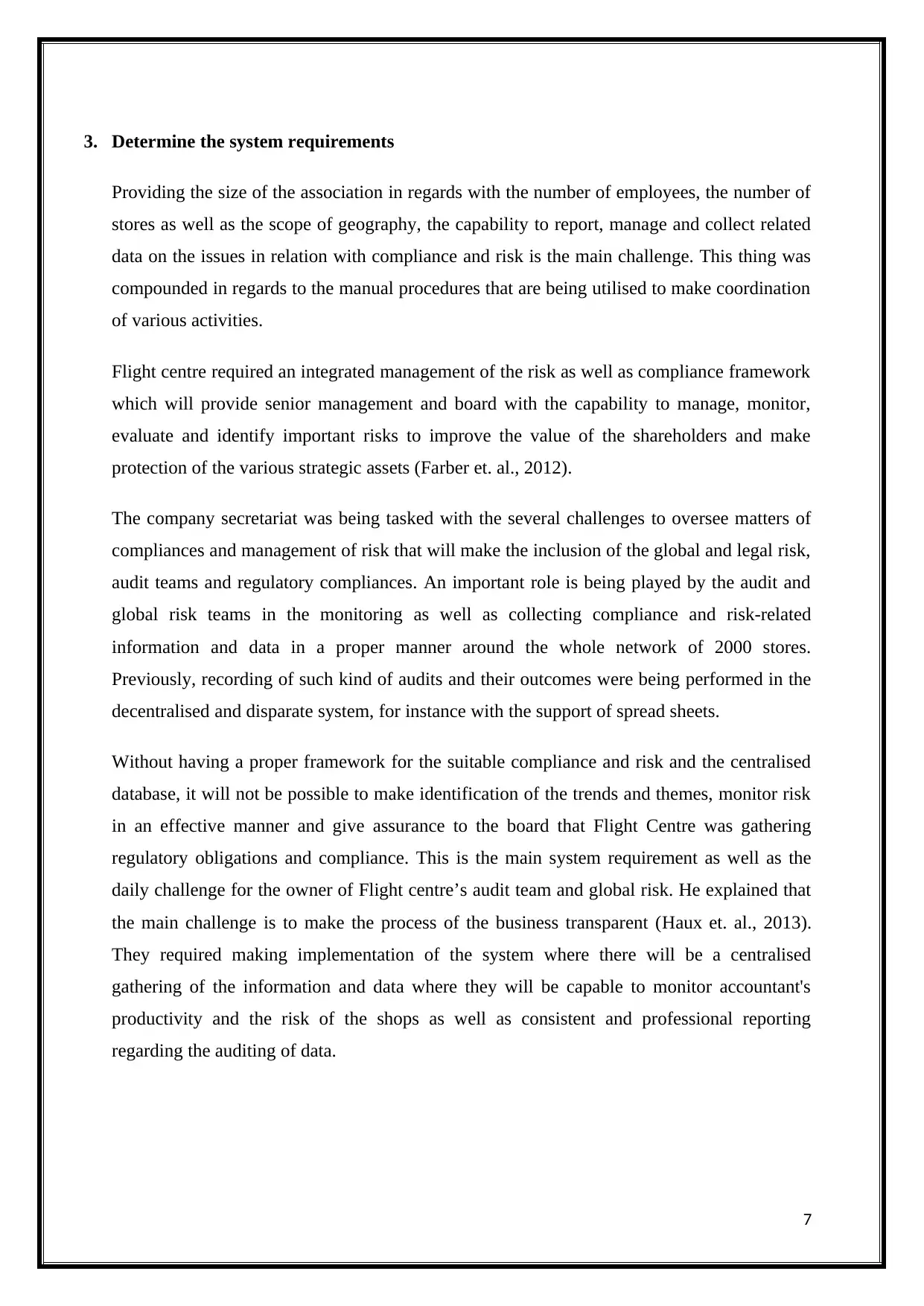
3. Determine the system requirements
Providing the size of the association in regards with the number of employees, the number of
stores as well as the scope of geography, the capability to report, manage and collect related
data on the issues in relation with compliance and risk is the main challenge. This thing was
compounded in regards to the manual procedures that are being utilised to make coordination
of various activities.
Flight centre required an integrated management of the risk as well as compliance framework
which will provide senior management and board with the capability to manage, monitor,
evaluate and identify important risks to improve the value of the shareholders and make
protection of the various strategic assets (Farber et. al., 2012).
The company secretariat was being tasked with the several challenges to oversee matters of
compliances and management of risk that will make the inclusion of the global and legal risk,
audit teams and regulatory compliances. An important role is being played by the audit and
global risk teams in the monitoring as well as collecting compliance and risk-related
information and data in a proper manner around the whole network of 2000 stores.
Previously, recording of such kind of audits and their outcomes were being performed in the
decentralised and disparate system, for instance with the support of spread sheets.
Without having a proper framework for the suitable compliance and risk and the centralised
database, it will not be possible to make identification of the trends and themes, monitor risk
in an effective manner and give assurance to the board that Flight Centre was gathering
regulatory obligations and compliance. This is the main system requirement as well as the
daily challenge for the owner of Flight centre’s audit team and global risk. He explained that
the main challenge is to make the process of the business transparent (Haux et. al., 2013).
They required making implementation of the system where there will be a centralised
gathering of the information and data where they will be capable to monitor accountant's
productivity and the risk of the shops as well as consistent and professional reporting
regarding the auditing of data.
7
Providing the size of the association in regards with the number of employees, the number of
stores as well as the scope of geography, the capability to report, manage and collect related
data on the issues in relation with compliance and risk is the main challenge. This thing was
compounded in regards to the manual procedures that are being utilised to make coordination
of various activities.
Flight centre required an integrated management of the risk as well as compliance framework
which will provide senior management and board with the capability to manage, monitor,
evaluate and identify important risks to improve the value of the shareholders and make
protection of the various strategic assets (Farber et. al., 2012).
The company secretariat was being tasked with the several challenges to oversee matters of
compliances and management of risk that will make the inclusion of the global and legal risk,
audit teams and regulatory compliances. An important role is being played by the audit and
global risk teams in the monitoring as well as collecting compliance and risk-related
information and data in a proper manner around the whole network of 2000 stores.
Previously, recording of such kind of audits and their outcomes were being performed in the
decentralised and disparate system, for instance with the support of spread sheets.
Without having a proper framework for the suitable compliance and risk and the centralised
database, it will not be possible to make identification of the trends and themes, monitor risk
in an effective manner and give assurance to the board that Flight Centre was gathering
regulatory obligations and compliance. This is the main system requirement as well as the
daily challenge for the owner of Flight centre’s audit team and global risk. He explained that
the main challenge is to make the process of the business transparent (Haux et. al., 2013).
They required making implementation of the system where there will be a centralised
gathering of the information and data where they will be capable to monitor accountant's
productivity and the risk of the shops as well as consistent and professional reporting
regarding the auditing of data.
7
Paraphrase This Document
Need a fresh take? Get an instant paraphrase of this document with our AI Paraphraser
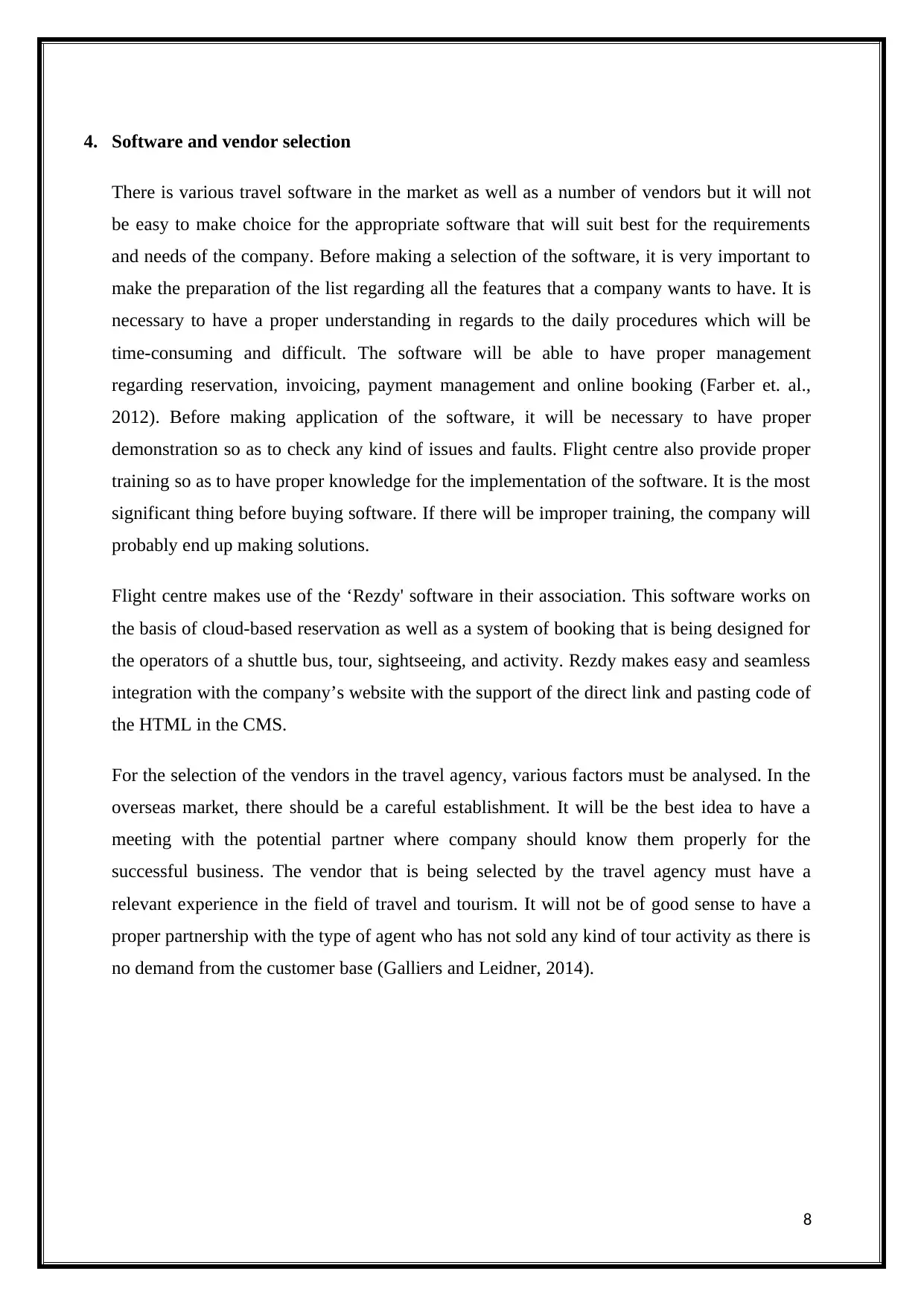
4. Software and vendor selection
There is various travel software in the market as well as a number of vendors but it will not
be easy to make choice for the appropriate software that will suit best for the requirements
and needs of the company. Before making a selection of the software, it is very important to
make the preparation of the list regarding all the features that a company wants to have. It is
necessary to have a proper understanding in regards to the daily procedures which will be
time-consuming and difficult. The software will be able to have proper management
regarding reservation, invoicing, payment management and online booking (Farber et. al.,
2012). Before making application of the software, it will be necessary to have proper
demonstration so as to check any kind of issues and faults. Flight centre also provide proper
training so as to have proper knowledge for the implementation of the software. It is the most
significant thing before buying software. If there will be improper training, the company will
probably end up making solutions.
Flight centre makes use of the ‘Rezdy' software in their association. This software works on
the basis of cloud-based reservation as well as a system of booking that is being designed for
the operators of a shuttle bus, tour, sightseeing, and activity. Rezdy makes easy and seamless
integration with the company’s website with the support of the direct link and pasting code of
the HTML in the CMS.
For the selection of the vendors in the travel agency, various factors must be analysed. In the
overseas market, there should be a careful establishment. It will be the best idea to have a
meeting with the potential partner where company should know them properly for the
successful business. The vendor that is being selected by the travel agency must have a
relevant experience in the field of travel and tourism. It will not be of good sense to have a
proper partnership with the type of agent who has not sold any kind of tour activity as there is
no demand from the customer base (Galliers and Leidner, 2014).
8
There is various travel software in the market as well as a number of vendors but it will not
be easy to make choice for the appropriate software that will suit best for the requirements
and needs of the company. Before making a selection of the software, it is very important to
make the preparation of the list regarding all the features that a company wants to have. It is
necessary to have a proper understanding in regards to the daily procedures which will be
time-consuming and difficult. The software will be able to have proper management
regarding reservation, invoicing, payment management and online booking (Farber et. al.,
2012). Before making application of the software, it will be necessary to have proper
demonstration so as to check any kind of issues and faults. Flight centre also provide proper
training so as to have proper knowledge for the implementation of the software. It is the most
significant thing before buying software. If there will be improper training, the company will
probably end up making solutions.
Flight centre makes use of the ‘Rezdy' software in their association. This software works on
the basis of cloud-based reservation as well as a system of booking that is being designed for
the operators of a shuttle bus, tour, sightseeing, and activity. Rezdy makes easy and seamless
integration with the company’s website with the support of the direct link and pasting code of
the HTML in the CMS.
For the selection of the vendors in the travel agency, various factors must be analysed. In the
overseas market, there should be a careful establishment. It will be the best idea to have a
meeting with the potential partner where company should know them properly for the
successful business. The vendor that is being selected by the travel agency must have a
relevant experience in the field of travel and tourism. It will not be of good sense to have a
proper partnership with the type of agent who has not sold any kind of tour activity as there is
no demand from the customer base (Galliers and Leidner, 2014).
8
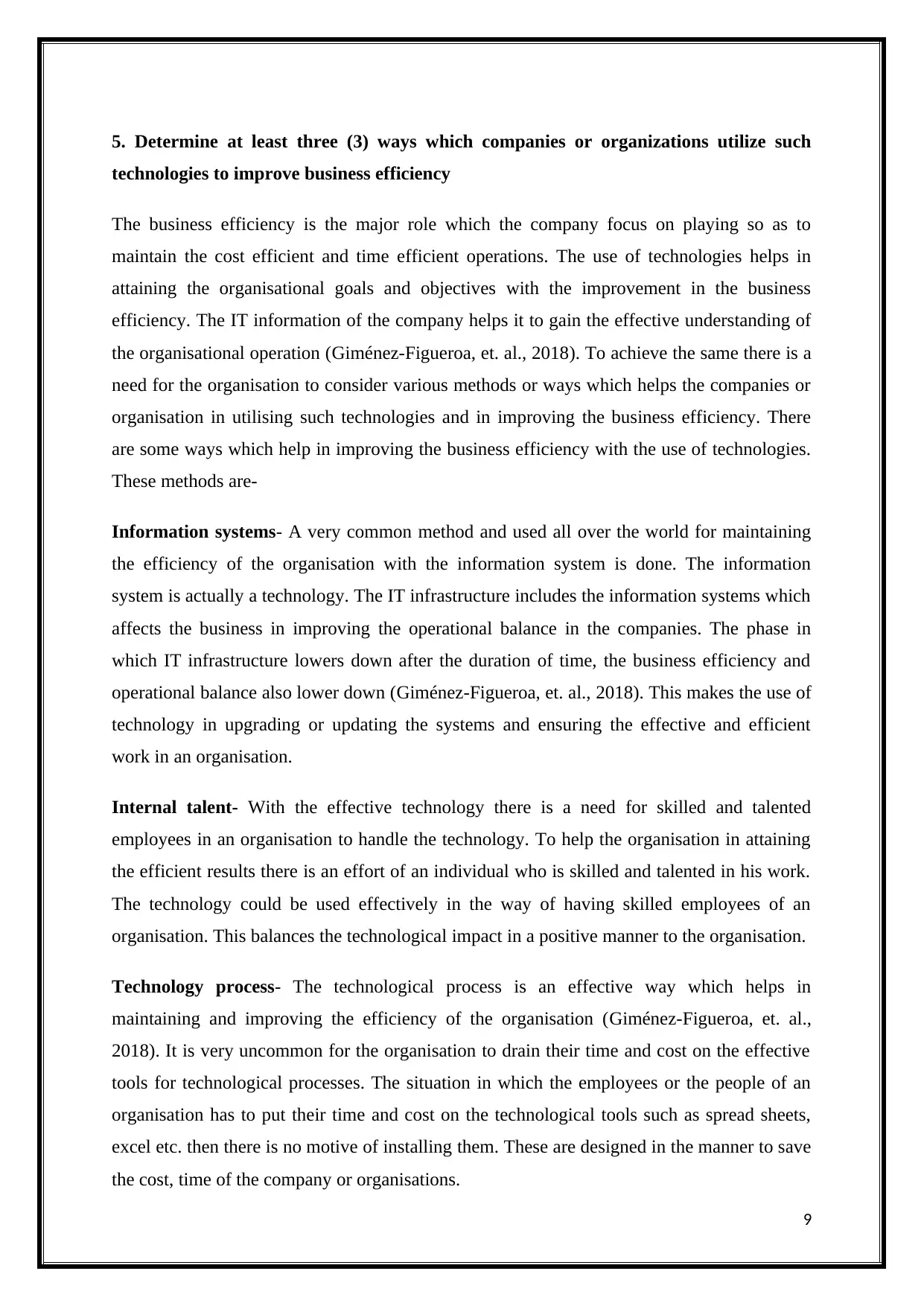
5. Determine at least three (3) ways which companies or organizations utilize such
technologies to improve business efficiency
The business efficiency is the major role which the company focus on playing so as to
maintain the cost efficient and time efficient operations. The use of technologies helps in
attaining the organisational goals and objectives with the improvement in the business
efficiency. The IT information of the company helps it to gain the effective understanding of
the organisational operation (Giménez-Figueroa, et. al., 2018). To achieve the same there is a
need for the organisation to consider various methods or ways which helps the companies or
organisation in utilising such technologies and in improving the business efficiency. There
are some ways which help in improving the business efficiency with the use of technologies.
These methods are-
Information systems- A very common method and used all over the world for maintaining
the efficiency of the organisation with the information system is done. The information
system is actually a technology. The IT infrastructure includes the information systems which
affects the business in improving the operational balance in the companies. The phase in
which IT infrastructure lowers down after the duration of time, the business efficiency and
operational balance also lower down (Giménez-Figueroa, et. al., 2018). This makes the use of
technology in upgrading or updating the systems and ensuring the effective and efficient
work in an organisation.
Internal talent- With the effective technology there is a need for skilled and talented
employees in an organisation to handle the technology. To help the organisation in attaining
the efficient results there is an effort of an individual who is skilled and talented in his work.
The technology could be used effectively in the way of having skilled employees of an
organisation. This balances the technological impact in a positive manner to the organisation.
Technology process- The technological process is an effective way which helps in
maintaining and improving the efficiency of the organisation (Giménez-Figueroa, et. al.,
2018). It is very uncommon for the organisation to drain their time and cost on the effective
tools for technological processes. The situation in which the employees or the people of an
organisation has to put their time and cost on the technological tools such as spread sheets,
excel etc. then there is no motive of installing them. These are designed in the manner to save
the cost, time of the company or organisations.
9
technologies to improve business efficiency
The business efficiency is the major role which the company focus on playing so as to
maintain the cost efficient and time efficient operations. The use of technologies helps in
attaining the organisational goals and objectives with the improvement in the business
efficiency. The IT information of the company helps it to gain the effective understanding of
the organisational operation (Giménez-Figueroa, et. al., 2018). To achieve the same there is a
need for the organisation to consider various methods or ways which helps the companies or
organisation in utilising such technologies and in improving the business efficiency. There
are some ways which help in improving the business efficiency with the use of technologies.
These methods are-
Information systems- A very common method and used all over the world for maintaining
the efficiency of the organisation with the information system is done. The information
system is actually a technology. The IT infrastructure includes the information systems which
affects the business in improving the operational balance in the companies. The phase in
which IT infrastructure lowers down after the duration of time, the business efficiency and
operational balance also lower down (Giménez-Figueroa, et. al., 2018). This makes the use of
technology in upgrading or updating the systems and ensuring the effective and efficient
work in an organisation.
Internal talent- With the effective technology there is a need for skilled and talented
employees in an organisation to handle the technology. To help the organisation in attaining
the efficient results there is an effort of an individual who is skilled and talented in his work.
The technology could be used effectively in the way of having skilled employees of an
organisation. This balances the technological impact in a positive manner to the organisation.
Technology process- The technological process is an effective way which helps in
maintaining and improving the efficiency of the organisation (Giménez-Figueroa, et. al.,
2018). It is very uncommon for the organisation to drain their time and cost on the effective
tools for technological processes. The situation in which the employees or the people of an
organisation has to put their time and cost on the technological tools such as spread sheets,
excel etc. then there is no motive of installing them. These are designed in the manner to save
the cost, time of the company or organisations.
9
⊘ This is a preview!⊘
Do you want full access?
Subscribe today to unlock all pages.

Trusted by 1+ million students worldwide
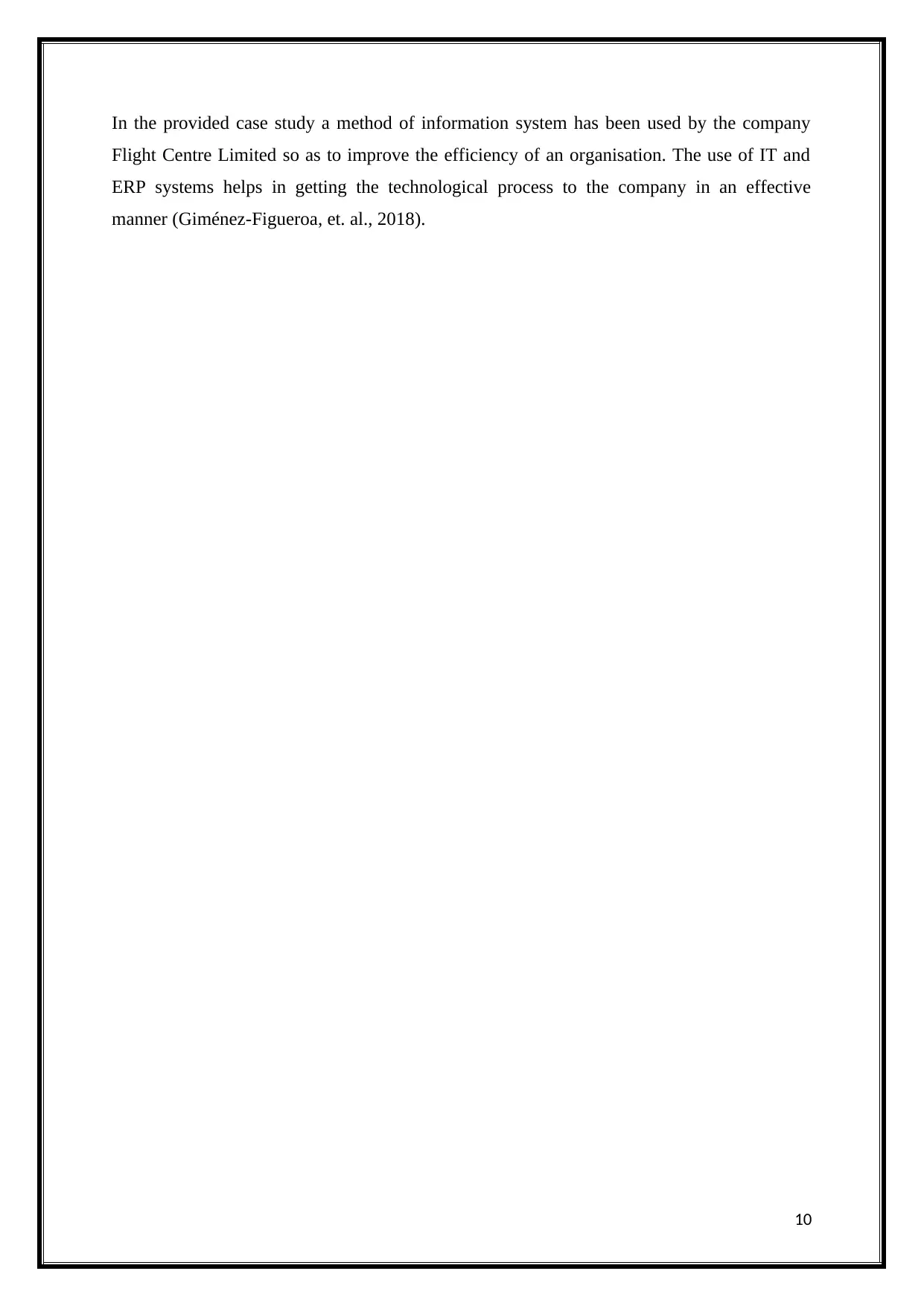
In the provided case study a method of information system has been used by the company
Flight Centre Limited so as to improve the efficiency of an organisation. The use of IT and
ERP systems helps in getting the technological process to the company in an effective
manner (Giménez-Figueroa, et. al., 2018).
10
Flight Centre Limited so as to improve the efficiency of an organisation. The use of IT and
ERP systems helps in getting the technological process to the company in an effective
manner (Giménez-Figueroa, et. al., 2018).
10
Paraphrase This Document
Need a fresh take? Get an instant paraphrase of this document with our AI Paraphraser
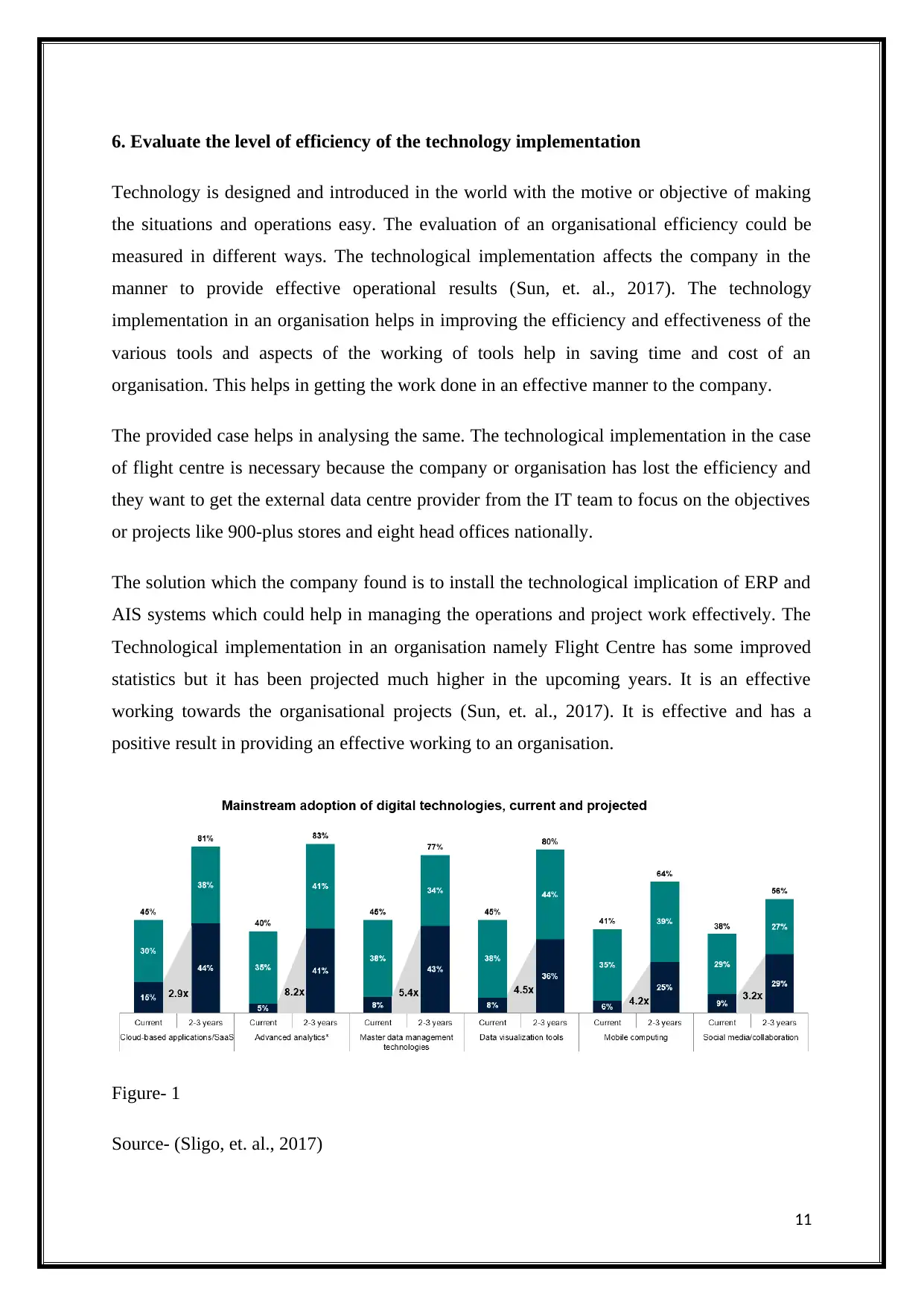
6. Evaluate the level of efficiency of the technology implementation
Technology is designed and introduced in the world with the motive or objective of making
the situations and operations easy. The evaluation of an organisational efficiency could be
measured in different ways. The technological implementation affects the company in the
manner to provide effective operational results (Sun, et. al., 2017). The technology
implementation in an organisation helps in improving the efficiency and effectiveness of the
various tools and aspects of the working of tools help in saving time and cost of an
organisation. This helps in getting the work done in an effective manner to the company.
The provided case helps in analysing the same. The technological implementation in the case
of flight centre is necessary because the company or organisation has lost the efficiency and
they want to get the external data centre provider from the IT team to focus on the objectives
or projects like 900-plus stores and eight head offices nationally.
The solution which the company found is to install the technological implication of ERP and
AIS systems which could help in managing the operations and project work effectively. The
Technological implementation in an organisation namely Flight Centre has some improved
statistics but it has been projected much higher in the upcoming years. It is an effective
working towards the organisational projects (Sun, et. al., 2017). It is effective and has a
positive result in providing an effective working to an organisation.
Figure- 1
Source- (Sligo, et. al., 2017)
11
Technology is designed and introduced in the world with the motive or objective of making
the situations and operations easy. The evaluation of an organisational efficiency could be
measured in different ways. The technological implementation affects the company in the
manner to provide effective operational results (Sun, et. al., 2017). The technology
implementation in an organisation helps in improving the efficiency and effectiveness of the
various tools and aspects of the working of tools help in saving time and cost of an
organisation. This helps in getting the work done in an effective manner to the company.
The provided case helps in analysing the same. The technological implementation in the case
of flight centre is necessary because the company or organisation has lost the efficiency and
they want to get the external data centre provider from the IT team to focus on the objectives
or projects like 900-plus stores and eight head offices nationally.
The solution which the company found is to install the technological implication of ERP and
AIS systems which could help in managing the operations and project work effectively. The
Technological implementation in an organisation namely Flight Centre has some improved
statistics but it has been projected much higher in the upcoming years. It is an effective
working towards the organisational projects (Sun, et. al., 2017). It is effective and has a
positive result in providing an effective working to an organisation.
Figure- 1
Source- (Sligo, et. al., 2017)
11
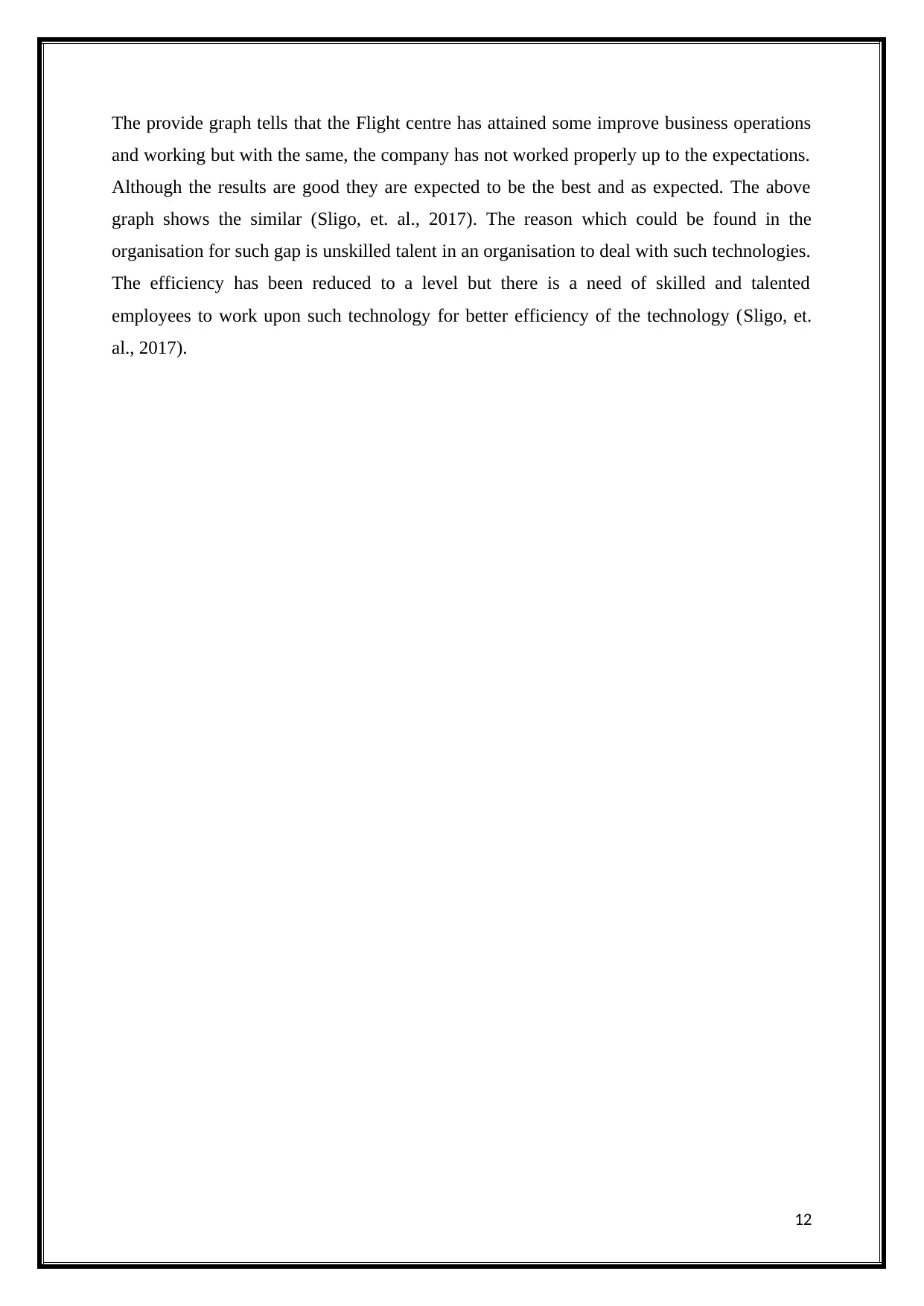
The provide graph tells that the Flight centre has attained some improve business operations
and working but with the same, the company has not worked properly up to the expectations.
Although the results are good they are expected to be the best and as expected. The above
graph shows the similar (Sligo, et. al., 2017). The reason which could be found in the
organisation for such gap is unskilled talent in an organisation to deal with such technologies.
The efficiency has been reduced to a level but there is a need of skilled and talented
employees to work upon such technology for better efficiency of the technology (Sligo, et.
al., 2017).
12
and working but with the same, the company has not worked properly up to the expectations.
Although the results are good they are expected to be the best and as expected. The above
graph shows the similar (Sligo, et. al., 2017). The reason which could be found in the
organisation for such gap is unskilled talent in an organisation to deal with such technologies.
The efficiency has been reduced to a level but there is a need of skilled and talented
employees to work upon such technology for better efficiency of the technology (Sligo, et.
al., 2017).
12
⊘ This is a preview!⊘
Do you want full access?
Subscribe today to unlock all pages.

Trusted by 1+ million students worldwide
1 out of 18
Related Documents
Your All-in-One AI-Powered Toolkit for Academic Success.
+13062052269
info@desklib.com
Available 24*7 on WhatsApp / Email
![[object Object]](/_next/static/media/star-bottom.7253800d.svg)
Unlock your academic potential
Copyright © 2020–2025 A2Z Services. All Rights Reserved. Developed and managed by ZUCOL.





